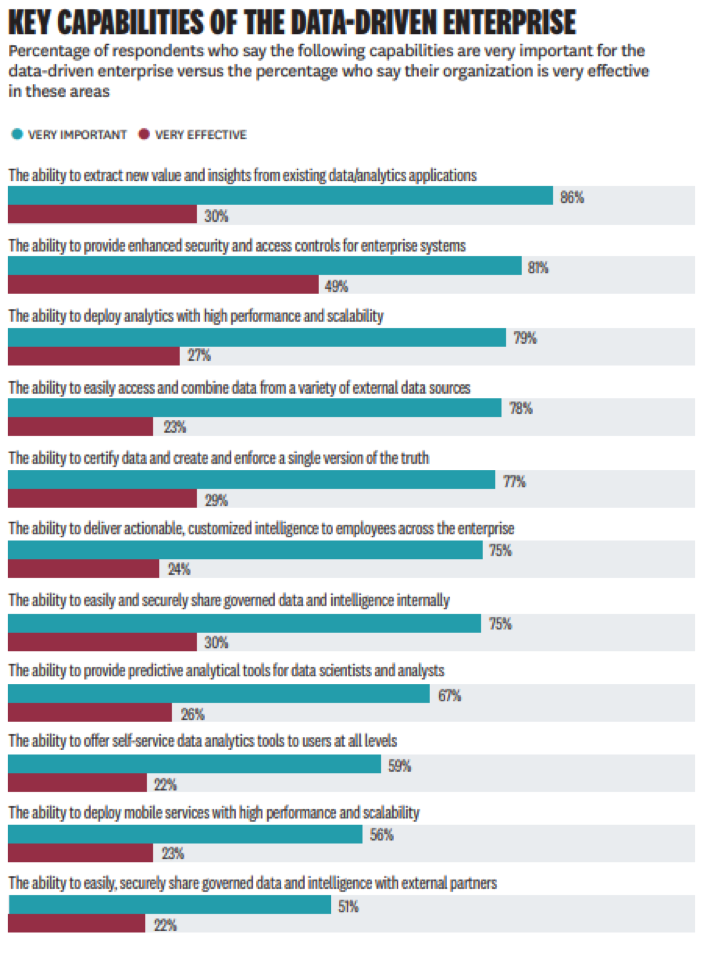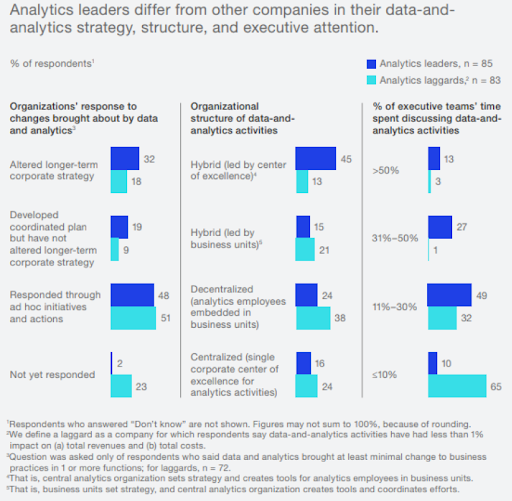Source: McKinsey
Data makes the world go round. Powerful advances in data collection technologies and business intelligence platforms help companies keep better track of market variables. Insights from this kind of data help leaders make informed decisions and grow their business. There are three critical trends in data and analytics that no business can afford to ignore:
1. Automation becomes all-pervasive
It seems like just yesterday when marketing automation burst into the market and simplified large swathes of branding and promotion activities. Similarly, most analytics tasks are now being automated, leaving data scientists free to interpret and apply their learnings, to offer more value to their organizations.
Data from Gartner shows that by 2020, over 40% of data science tasks will be automated. Think clean-up of all incoming data, creation of automated weekly reports, multivariate testing and analysis, all done automatically, with little to no human input. Naturally, this saved time can translate into better productivity across teams. It can also bring faster understanding of data that can be applied more quickly to achieve business results.
2. Machine learning, artificial intelligence, and natural language querying skills are necessary
No, this isn’t just a word-salad of the trendiest words at the moment. It’s a statement of fact.
There was a time when good data scientists could get by with knowing just how to use a spreadsheet program and know their numbers. Today, data analysts are part developer, and part data detective. They’re expected to know multiple types of database, use SQL and natural language processing to write queries to pull required data sets, create smart algorithms that “learn” from each cycle and more.
By the year 2020, half of all analytical queries that the average BI team deals with will be generated through voice search, NLP or even plain old-fashioned text search, as per data shared by Gartner at their Data & Analytics Summit in Sydney earlier this year.
As data sets get larger, more complex and the time needed to spit out an accurate result keeps getting shorter, artificial intelligence (AI) has stepped in to fill the gaps. Self-learning algorithms offer recommendations based on a combination of static and dynamic variables – something that would have been impossible to pull off manually by a team of data scientists working around the clock.
This combination of machine learning and AI techniques is believed to usher in the era of “Augmented Analytics” (a concept introduced by Gartner in a 2017 report). Augmented Analytics uses algorithms to automate insight generation and reduces a company’s dependence on data analysts and scientists in the process.
3. Data security takes on a whole new level of urgency
Lately, data breaches have become as common as the stripes on a zebra. From poor user authentication practices to hijacked APIs and user accounts, the various ways in which data continues to be compromised is mind boggling. Couple that with the knowledge that identity theft is a real, everyday occurrence that happens to one in three data breach victims, and we have a critical situation where nobody has a private life anymore.
To put this into perspective, the cybercrime industry was worth $1.5 trillion in 2018. That’s a good 70 billion more than the GDP of Australia!
The enormity of the problem explains why managing personal data and securing it from external threats will be the biggest concern for 70% of organizations in 2020, according to Gartner research.
Encrypting data as it sits in the cloud or physical servers helps prevent potential misuse of the data if it were to fall into the wrong hands. Hashed and salted passwords are already commonly used to protect user data from identity thieves. A Nutanix study titled Top 10 Cloud Security Trends for 2019 delves deep into the 10 most important ways to secure an organization’s data from vulnerabilities at every stage in the usage cycle.
All Eyes on the Trend Line
Data will talk to you, if you’ll listen.
Despite all the effort that goes into capturing, storing, analyzing and interpreting data, companies still make a beeline for best in class analytics, because they understand that when implemented right, business analytics gives an average ROI of 112% in 5 years.
That’s more than can be said for most business processes. As the world rapidly moves towards a data-first approach, it helps to know that smart bets on data and analytics can keep businesses ahead of the curve, the competition and the threat of obsolescence.
Dipti Parmar is a contributing writer. She has written for CIO.com, Entrepreneur, CMO.com and Inc. Magazine. Follow her on Twitter @dipTparmar.
© 2019 Nutanix, Inc. All rights reserved. For additional legal information, please go here.







